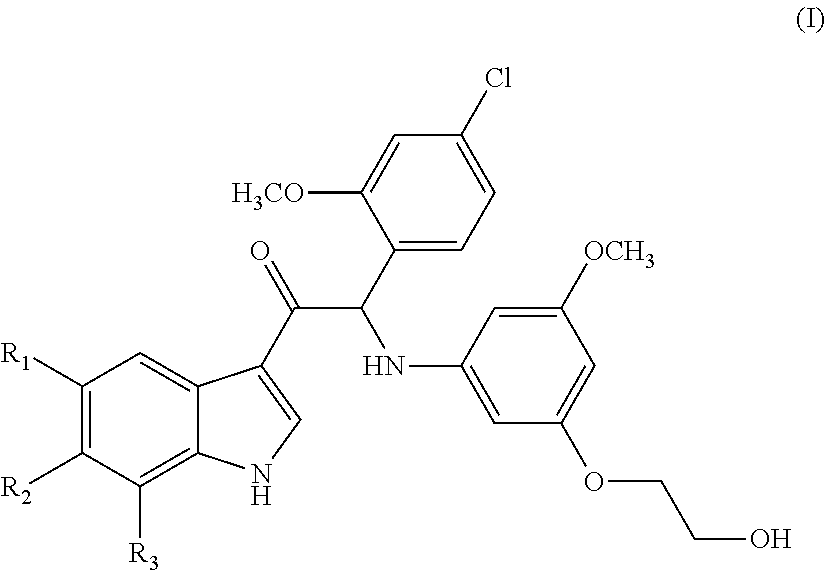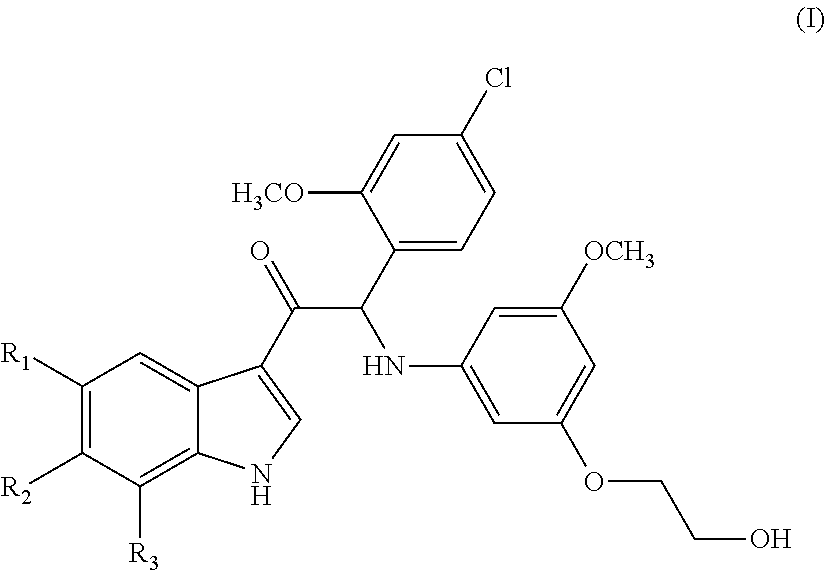Mono- or di-substituted indole derivatives as dengue viral replication inhibitors
- Summary
- Abstract
- Description
- Claims
- Application Information
AI Technical Summary
Benefits of technology
Problems solved by technology
Method used
Image
Examples
example 1
of 2-(4-chloro-2-methoxyphenyl)-1-(6-fluoro-1H-indol-3-yl)-2-((3-(2-hydroxyethoxy)-5-methoxyphenyl)amino)ethanone (Compound 1) and Chiral Separation into Enantiomers 1A and 1B
[0057]
[0058]Synthesis of Intermediate 1a:
[0059]2-(4-Chloro-2-methoxyphenyl)acetic acid [CAS 170737-95-8] (5.8 g, 28.9 mmol) was added in small portions to thionyl chloride (50 mL) and the resulting solution was stirred overnight at 60° C. The solvent was concentrated under reduced pressure and co-evaporated with toluene to give 2-(4-chloro-2-methoxyphenyl)acetyl chloride 1a (6.5 g) as an oily residue that was used without further purification in the next step.
[0060]Synthesis of Intermediate 1b:
[0061]Diethylaluminum chloride 1M in hexane (37.1 mL, 37.14 mmol) was added dropwise at 0° C. to a solution of 6-fluoro-1H-indole [CAS 399-51-9] (3.34 g, 24.76 mmol) in CH2Cl2 (100 mL). After 30 min at 0° C., a solution of 2-(4-chloro-2-methoxyphenyl)acetyl chloride 1a (6.3 g, 28.76 mmol) in CH2Cl2 (100 mL) was added slow...
example 1.1
ility of Enantiomer 1A at pH 7.4
[0080]The chiral stability of Enantiomer 1A (R=OMe) was evaluated by determination of the enantiomeric excess (ee %) after incubation for 24 h and 48 h in a buffered solution at pH 7.4 at 40° C. and 60° C. To assess the influence of the methoxy-substituent of Enantiomer 1A (R=OMe) on the stability against racemization, the chiral stability of Enantiomer 1′A (R═H) was tested under the same conditions.
[0081]To this end, 5 μM buffered (pH=7.4) solutions of 1A and 1′A were prepared by mixing 25 μL of a 100 μM solution of 1A or 1′A in DMSO with 475 μL aqueous buffer pH 7.4. Samples were taken 24 h and 48 h after incubation at 40° C. and 60° C. The analytical samples were analyzed by Chiral SFC (MS detection) and the chiral purity was expressed as the enantiomeric excess (ee %=% enantiomer A−% enantiomer B). Both Enantiomers 1A and 1′A had a chiral purity of 100% prior to their incubation.
ee %Sampling timepoints (h)CompoundTemperature24481A 40° C.10010060° ...
example 2
of 2-(4-chloro-2-methoxyphenyl)-1-(6-fluoro-7-methyl-1H-indol-3-yl)-2-((3-(2-hydroxyethoxy)-5-methoxyphenyl)amino)ethanone (Compound 2) and Chiral Separation into Enantiomers 2A and 2B
[0082]
[0083]Synthesis of Intermediate 2a:
[0084]A solution of 6-fluoro-7-methyl-1H-indole [CAS 57817-10-4] (1.10 g, 7.37 mmol) in CH2Cl2 (40 mL) was cooled on an ice-bath under N2-flow. Diethylaluminum chloride 1M in hexane (10 mL, 10 mmol) was added dropwise over 15 min. After additional stirring for 15 min at 0° C., a solution of 2-(4-chloro-2-methoxy-phenyl)acetyl chloride 1a (2.06 g, 9.42 mmol, synthesis: see example 1) in CH2Cl2 (35 mL) was added over 75 min at 0° C. The reaction was stirred at 0° C. for 1 h and subsequently quenched by slow addition of a solution of potassium sodium tartrate tetrahydrate (Rochelle salt) [CAS 6100-16-9] (4.24 g, 15 mmol) in water (10 mL), while keeping the internal temperature of the mixture below 10° C. The ice-bath was removed, 2-methyl-THF (160 mL) and Na2SO4 (6...
PUM
| Property | Measurement | Unit |
|---|---|---|
| Therapeutic | aaaaa | aaaaa |
| Antimicrobial properties | aaaaa | aaaaa |
Abstract
Description
Claims
Application Information
 Login to View More
Login to View More - R&D
- Intellectual Property
- Life Sciences
- Materials
- Tech Scout
- Unparalleled Data Quality
- Higher Quality Content
- 60% Fewer Hallucinations
Browse by: Latest US Patents, China's latest patents, Technical Efficacy Thesaurus, Application Domain, Technology Topic, Popular Technical Reports.
© 2025 PatSnap. All rights reserved.Legal|Privacy policy|Modern Slavery Act Transparency Statement|Sitemap|About US| Contact US: help@patsnap.com



